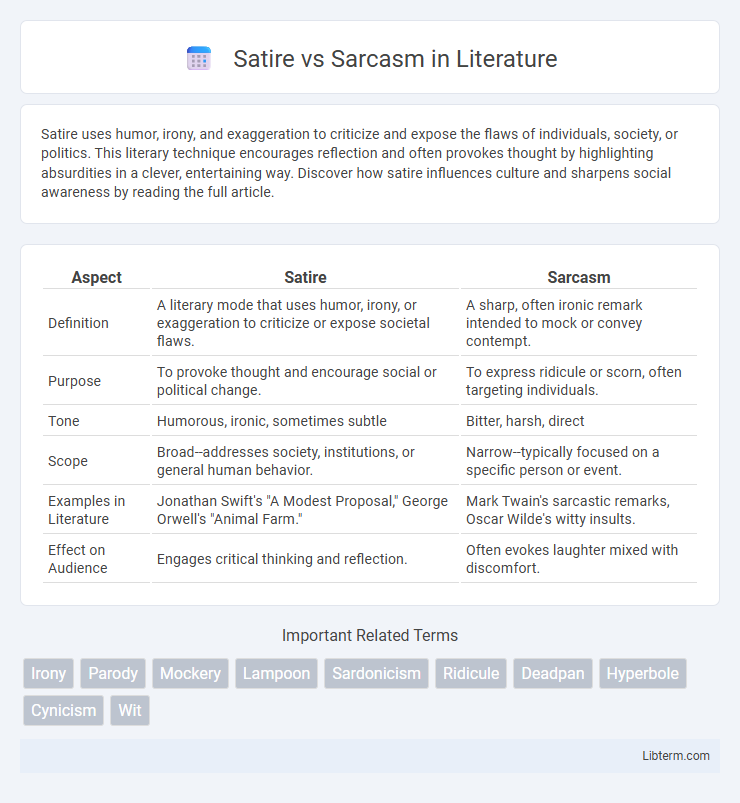Satire uses humor, irony, and exaggeration to criticize and expose the flaws of individuals, society, or politics. This literary technique encourages reflection and often provokes thought by highlighting absurdities in a clever, entertaining way. Discover how satire influences culture and sharpens social awareness by reading the full article.
Table of Comparison
| Aspect | Satire | Sarcasm |
|---|---|---|
| Definition | A literary mode that uses humor, irony, or exaggeration to criticize or expose societal flaws. | A sharp, often ironic remark intended to mock or convey contempt. |
| Purpose | To provoke thought and encourage social or political change. | To express ridicule or scorn, often targeting individuals. |
| Tone | Humorous, ironic, sometimes subtle | Bitter, harsh, direct |
| Scope | Broad--addresses society, institutions, or general human behavior. | Narrow--typically focused on a specific person or event. |
| Examples in Literature | Jonathan Swift's "A Modest Proposal," George Orwell's "Animal Farm." | Mark Twain's sarcastic remarks, Oscar Wilde's witty insults. |
| Effect on Audience | Engages critical thinking and reflection. | Often evokes laughter mixed with discomfort. |
Understanding Satire: Definition and Purpose
Satire is a literary technique used to expose and criticize human vices or societal flaws through humor, irony, and exaggeration. Its primary purpose is to provoke thought and inspire change by highlighting the absurdity of certain behaviors or institutions. Unlike sarcasm, which often aims to mock or insult, satire seeks to deliver a deeper social or political message with wit and subtlety.
What Is Sarcasm? A Closer Look
Sarcasm is a form of verbal irony where the speaker says the opposite of what they truly mean, often with a tone of mockery or disdain to convey contempt or humor. It relies on vocal cues, such as tone and pitch, to signal insincerity and is commonly used to criticize or ridicule. Unlike satire, which uses broader social commentary and irony, sarcasm is typically more direct and personal in its intent.
Key Differences Between Satire and Sarcasm
Satire uses humor, irony, and exaggeration to criticize or expose societal flaws, often aiming for social change or reflection. Sarcasm is a sharp, cutting remark intended to mock or convey contempt, typically targeting individuals rather than broad issues. While satire has a constructive purpose with layered meanings, sarcasm usually relies on tone and context to deliver direct, often hurtful, criticism.
Historical Roots of Satire and Sarcasm
Satire traces its origins to ancient Greece and Rome, where playwrights like Aristophanes and Horace used humor and irony to critique social and political issues. Sarcasm, derived from the Greek word "sarkazein," meaning "to tear flesh," evolved as a sharp, cutting form of verbal irony aimed at mocking or ridiculing individuals. Both literary devices have deep historical roots, with satire often serving a broader cultural critique and sarcasm functioning as pointed personal commentary.
Techniques Used in Satire Writing
Satire employs techniques such as irony, exaggeration, and parody to highlight societal flaws and provoke critical thinking. It often uses humor and wit to mask serious critiques, encouraging readers to question norms without overt confrontation. By contrasting reality with absurdity, satire effectively exposes human vices and institutional shortcomings.
Common Forms and Examples of Sarcasm
Sarcasm commonly appears as sharp, cutting remarks intended to mock or convey contempt, often using exaggerated tone or ironic statements. Examples include saying "Great job!" after someone makes a clear mistake or "Oh, fantastic!" when faced with an inconvenient situation. Sarcasm differs from satire by targeting individuals or specific actions with direct, biting comments, while satire uses humor and irony to critique society or broader issues.
Satire in Literature and Media
Satire in literature and media functions as a powerful tool for social critique, using humor, irony, and exaggeration to expose and challenge human vices, political corruption, and societal flaws. Works like Jonathan Swift's "A Modest Proposal" and television programs such as "The Daily Show" employ satire to provoke thought and inspire change by highlighting absurdities in contemporary issues. Unlike sarcasm, which often targets individuals with sharp ridicule, satire aims for broader cultural or institutional commentary, leveraging wit to engage audiences critically.
The Psychology Behind Satire and Sarcasm
Satire employs humor and irony to expose societal flaws, engaging the cognitive process of critical thinking and social reflection more deeply than sarcasm, which often relies on sharp, cutting remarks aimed at individuals to express contempt or mockery. Psychological studies reveal that satire activates abstract reasoning and empathy as it encourages audiences to recognize broader social issues, whereas sarcasm tends to trigger emotional defense mechanisms due to its personal and aggressive nature. Understanding these distinctions aids in grasping how satire can foster social awareness while sarcasm often serves as an immediate, emotionally charged social signal.
Impact of Satire vs Sarcasm on Society
Satire critiques social and political issues through humor and exaggeration, fostering awareness and encouraging critical thinking in society. Sarcasm often conveys contempt or ridicule, which can provoke emotional reactions but may also alienate or offend its audience. The impact of satire tends to be more constructive by promoting dialogue, whereas sarcasm risks undermining communication and social cohesion.
When to Use Satire or Sarcasm Effectively
Satire should be used effectively when aiming to critique societal issues or highlight human follies through humor and irony, often requiring a nuanced understanding of the audience's cultural context. Sarcasm is most impactful in informal settings or personal interactions where sharp, witty remarks can underscore criticism or mockery without causing misunderstanding. Recognizing the appropriate context and audience sensitivity ensures that satire and sarcasm communicate their messages without alienating or offending listeners.
Satire Infographic

 libterm.com
libterm.com